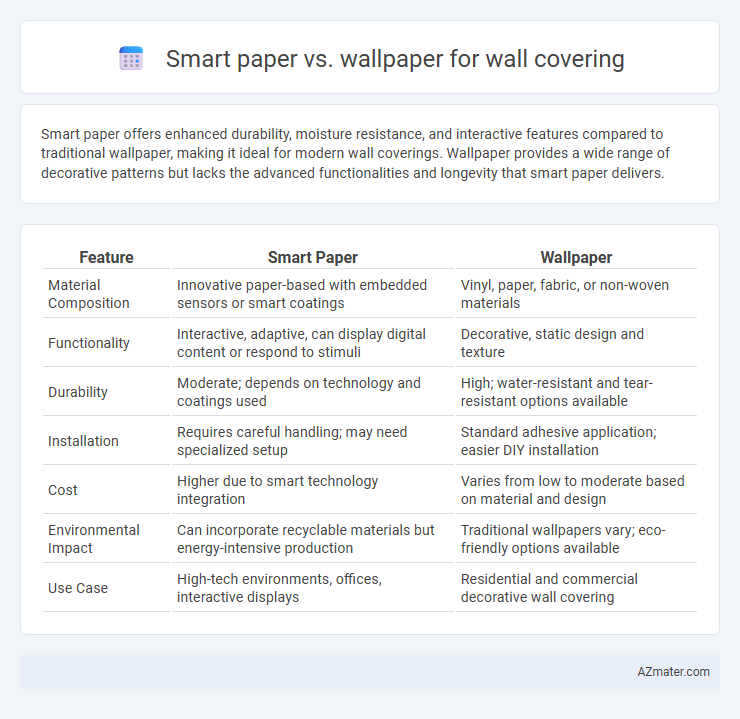Smart paper offers enhanced durability, moisture resistance, and interactive features compared to traditional wallpaper, making it ideal for modern wall coverings. Wallpaper provides a wide range of decorative patterns but lacks the advanced functionalities and longevity that smart paper delivers.
Table of Comparison
| Feature | Smart Paper | Wallpaper |
|---|---|---|
| Material Composition | Innovative paper-based with embedded sensors or smart coatings | Vinyl, paper, fabric, or non-woven materials |
| Functionality | Interactive, adaptive, can display digital content or respond to stimuli | Decorative, static design and texture |
| Durability | Moderate; depends on technology and coatings used | High; water-resistant and tear-resistant options available |
| Installation | Requires careful handling; may need specialized setup | Standard adhesive application; easier DIY installation |
| Cost | Higher due to smart technology integration | Varies from low to moderate based on material and design |
| Environmental Impact | Can incorporate recyclable materials but energy-intensive production | Traditional wallpapers vary; eco-friendly options available |
| Use Case | High-tech environments, offices, interactive displays | Residential and commercial decorative wall covering |
Introduction to Smart Paper and Traditional Wallpaper
Smart paper integrates advanced materials enabling features like self-adhesion, moisture resistance, and easy removability, revolutionizing wall covering solutions with durability and convenience. Traditional wallpaper, made from paper or vinyl, offers diverse patterns and textures but often requires paste application and careful installation. The evolving technology in smart paper introduces a more user-friendly and eco-conscious alternative to conventional wallpaper.
What is Smart Paper?
Smart Paper is an innovative wall covering made from durable, eco-friendly materials infused with technology that allows for easy customization, writing, and erasing, making it ideal for dynamic spaces like offices and classrooms. Unlike traditional Wallpaper, which is primarily decorative and static, Smart Paper offers interactive features such as writable surfaces compatible with dry-erase markers and printable designs that can be updated frequently. This combination of functionality and adaptability positions Smart Paper as a versatile alternative for creative and flexible wall applications.
Key Features of Traditional Wallpaper
Traditional wallpaper offers intricate patterns, textured finishes, and a wide range of colors, providing versatility in interior design. Its installation involves adhesive backing that bonds securely to walls but may require skilled labor to ensure smooth application without bubbles or wrinkles. Durable and often washable, traditional wallpaper enhances wall aesthetics while offering options for customization not commonly found in smart paper alternatives.
Durability Comparison: Smart Paper vs Wallpaper
Smart paper offers enhanced durability due to its tear-resistant and waterproof properties, making it ideal for high-traffic areas and humid environments. Traditional wallpaper, while available in durable vinyl and fabric options, tends to be more susceptible to tearing, moisture damage, and fading over time. Comparatively, smart paper delivers longer-lasting wall covering performance with easier maintenance and greater resistance to wear and environmental factors.
Installation Process of Smart Paper
Smart paper offers a streamlined installation process compared to traditional wallpaper, featuring peel-and-stick technology that eliminates the need for paste or water, reducing mess and setup time. Its lightweight design allows for easy application on smooth surfaces without specialized tools, making it ideal for DIY projects and quick wall transformations. Smart paper's repositionable adhesive enables precise alignment and bubble-free finishes, enhancing overall convenience during installation.
Maintenance and Cleaning Differences
Smart paper offers a highly durable surface with water-resistant coatings that allow for easy cleaning of stains and smudges using mild soap and a damp cloth, reducing maintenance efforts. Wallpaper, especially traditional paper-based types, tends to absorb moisture and is more susceptible to damage from cleaning solutions, requiring gentle treatment and sometimes professional care to avoid peeling or discoloration. Vinyl or washable wallpapers improve durability and simplify maintenance but generally do not match the advanced stain resistance and quick-clean properties found in smart paper technologies.
Design and Customization Options
Smart paper offers superior design flexibility with customizable patterns, colors, and textures that can be digitally printed to suit any aesthetic preference, enhancing personalization in wall covering. Wallpaper provides a wide variety of pre-designed styles, but customization is limited compared to smart paper's capability for bespoke, on-demand designs. Both options support unique design expressions, yet smart paper stands out for its ability to deliver tailor-made visuals that integrate seamlessly with modern interior design trends.
Eco-Friendliness and Safety Considerations
Smart paper offers a more sustainable option for wall covering due to its biodegradable materials and low VOC emissions, reducing indoor air pollution and environmental impact. Wallpaper often contains synthetic chemicals and plastics that can release harmful toxins over time, posing safety concerns for indoor air quality and human health. Choosing smart paper supports eco-friendly practices and safer living environments by minimizing chemical exposure and waste generation.
Cost Analysis: Smart Paper vs Wallpaper
Smart paper typically offers a cost-effective solution for wall covering, with prices ranging from $10 to $20 per roll, which is generally lower than traditional wallpaper costs that average between $25 and $50 per roll. Installation expenses for smart paper are often reduced due to its lightweight material and easy application process, saving up to 30% in labor costs compared to wallpaper that might require professional installation due to heavier materials and complex patterns. Long-term maintenance costs also favor smart paper, as its durable, water-resistant surface minimizes the need for frequent replacements or repairs common with conventional wallpaper.
Which Wall Covering is Right for You?
Smart paper offers moisture resistance, durability, and easy customization, making it ideal for high-traffic or humid areas, while wallpaper provides a wide range of textures, patterns, and designs for aesthetic appeal in low-moisture spaces. Consider your room's environment, maintenance preferences, and design goals to decide between smart paper's practical benefits and wallpaper's decorative versatility. Evaluating factors like installation complexity, longevity, and budget will help determine the best wall covering for your specific needs.

Infographic: Smart paper vs Wallpaper for Wall covering
 azmater.com
azmater.com